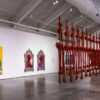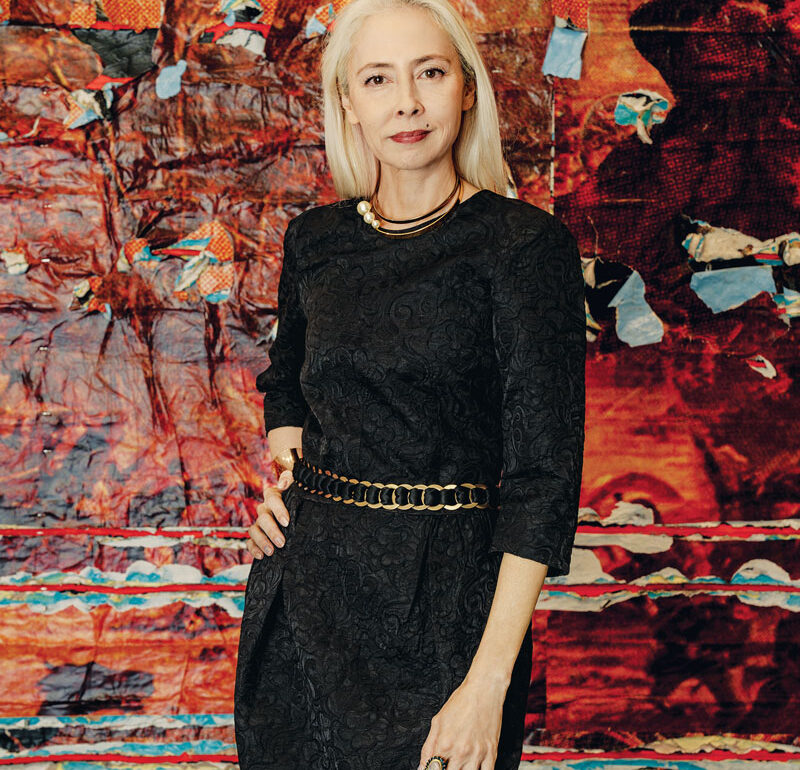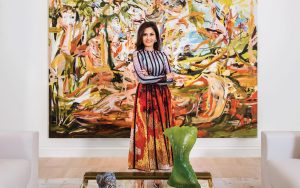Melissa Chiu
For Melissa Chiu, museums should be a place of “radical accessibility,” and since her appointment as the director of the Smithsonian’s Hirshhorn Museum and Sculpture Garden, that has continued to be her guiding vision. In the past decade, Chiu has doubled the institution’s attendance to more than one million visitors a year; launched an innovative digital platform, Hirshhorn Eye; built an international and diverse board; and, most important, positioned the museum as one for—and about—artists.
“When I first arrived at the Hirshhorn, it was at a moment when the contemporary art world was really changing,” says Chiu, who was formerly the director of the Asia Society Museum in New York. “We are on the National Mall in D.C. A lot of my focus has been to ask, What does it mean to fulfill on the national level with an international brief?”

Melissa Chiu in front of a monumental commission by Mark Bradford, Pickett’s Charge (2017), at the Hirshhorn Museum and Sculpture Garden in Washington, D.C. Photo: SHURAN HUANG
Committed to rewriting the Western art historical narrative, the museum is celebrating its 50th anniversary this year with “Revolutions: Art from the Hirshhorn Collection, 1860–1960,” a sprawling survey of more than 200 works from the founding collection alongside more recent contemporary acquisitions, on view through April 2025.
Milestone moment: One project that continues to define Chiu’s commitment to expanding access to art is “Yayoi Kusama: Infinity Mirrors” in 2017, which attracted nearly 500,000 visitors to the campus, a record-breaking number, and launched a reevaluation of the artist’s work. “Kusama’s ‘Infinity’ rooms were not considered an integral part of her practice at the time. I do think of that exhibition as a contribution to a new understanding of her work.”
Up next: Currently underway is a new sculpture garden on the mall that Chiu commissioned from artist Hiroshi Sugimoto, expected to increase visitorship threefold, followed by a revitalization of the museum building and plaza by Annabelle Selldorf, also featured in “Women Shaping the Art World.” “I think it will be one of the most visited cultural sites in this country,” Chiu says.

Hélène Nguyen-Ban with works from her expansive collection, including “Immersions, Black Supper I-V” (1990), a series by Andres Serrano on the wall, and Untitled (2018) by Oscar Murillo on the fireplace mantel. Photo: THEA LØVSTAD
Hélène Nguyen-Ban
As the founder of Docent, a trailblazing Spotify-like mobile app that leverages AI to provide personalized artwork recommendations, Hélène Nguyen-Ban is democratizing the world of art collecting—one search at a time. The entrepreneur and collector partnered with mathematician Mathieu Rosenbaum, as well as a team of machine learning engineers, data scientists, art historians, and market experts, to create the platform, which features over 20,000 artworks from 150 galleries across 30 countries and counting.
Docent “is a bit like a mentor, oracle, or pocket art adviser—capable of understanding your taste without needing explicit input,” says Nguyen-Ban, who spent a decade at LVMH before running her own gallery for six years. An avid collector of everything from artifacts and antiquities to contemporary work, she believes that “art has the unique power to inspire. It must be accessible to all.”
“I believe that art has the unique power to inspire, educate, and ignite the imagination”
Hélène Nguyen-Ban
Breaking barriers: “The art market largely remains an insider’s business—opaque and inaccessible to many enthusiasts. Collectors often struggle to discern their preferences amid trends, inadvertently overlooking emerging talents. Collecting should be an inspiring journey for everyone.”
Collaborative spirit: In May, the Invisible Collection teamed up with Docent to present the work of three female painters in New York. Docent also powered the art curation for esteemed Paris architect Aline Asmar d’Amman’s presentation “Love, Women, and the Sea” at last year’s Festival of Interior Design in Hyères, France.
Support network: “I have a profound commitment to fostering dialogue and cultural understanding through art,” says Nguyen-Ban, who is involved with the Tate, Palais de Tokyo, and the Centre Pompidou, among other institutions. She’s also the chair of Fluxus Art Projects. “My connection to these conversations runs deep, intertwining with both my work and personal life, guiding every decision I make.”
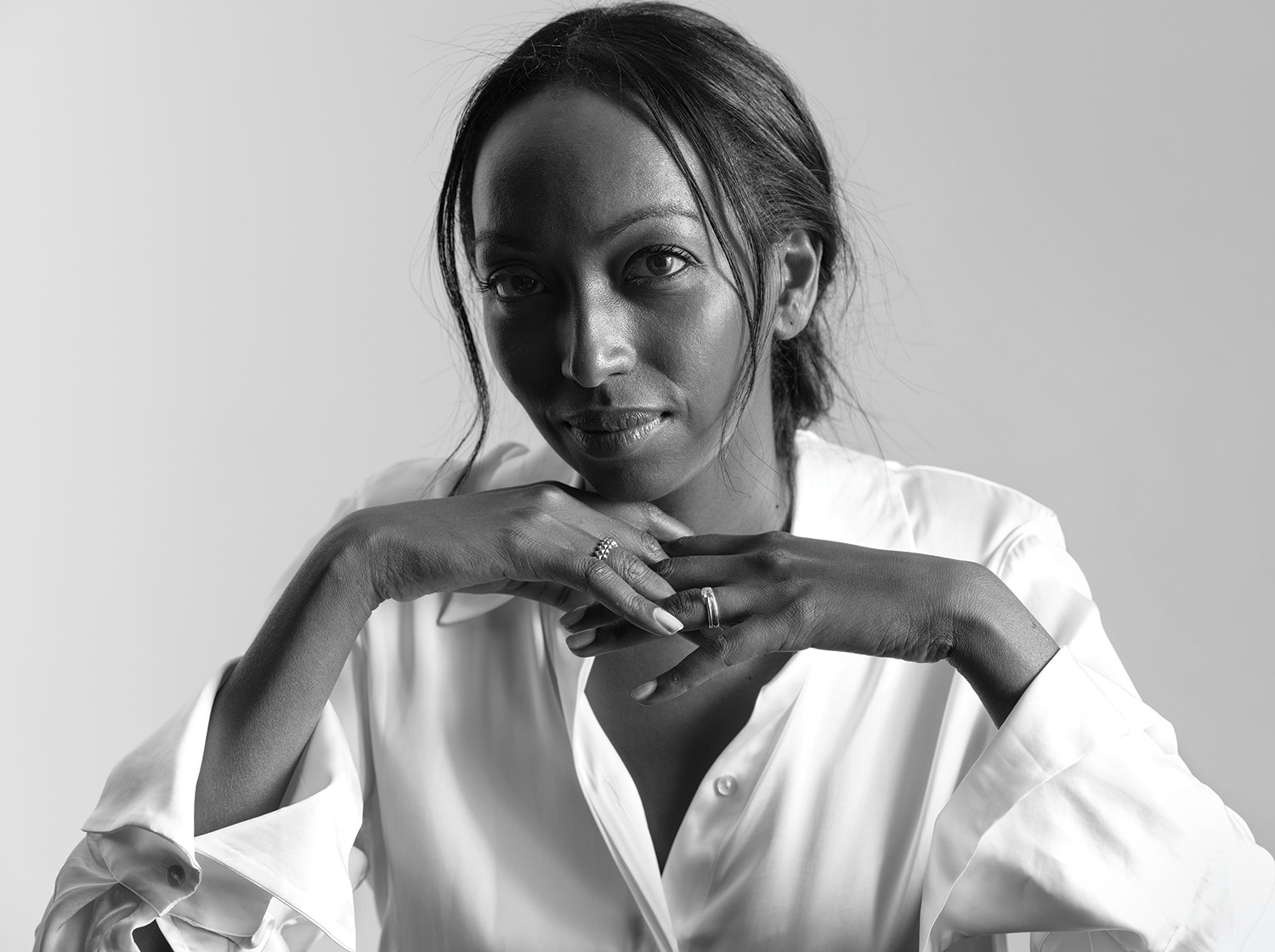
Mariane Ibrahim. Photo: Brigitte Lacombe
Mariane Ibrahim
“We never fit in the gallery ecosystem,” says Mariane Ibrahim, the esteemed dealer who has been forging her own path ever since she opened her first gallery, in Seattle in 2012. On a mission to “grow the next generation of artists and insert their vision within the spectrum of art history in a noncentric way,” she now operates major galleries in three cities: Chicago, Paris, and Mexico City, home to her latest outpost.
Global outlook: Born in New Caledonia to Somali parents and brought up in Bordeaux, France, Ibrahim represents a global lineup of talents, with more than half of her artists hailing from the Caribbean. “It is likely connected to my upbringing and vague memories of growing up on a tropical island,” says Ibrahim. “There is magic and mysticism in Caribbean culture, a supernatural and shape-shifting presence in the works of Afro-Caribbeans, broadly related to masquerade and disguise.”
“When I look at art, I see it as an invitation, a gateway of sorts”
Mariane Ibrahim
On the rise: Ibrahim possesses a unique gift for discovering and fostering new talent. Composed of art stars such as Amoako Boafo, Zohra Opoku, and Peter Uka (who is presenting a solo booth at Frieze in London in October), her roster is fast expanding with recent announcements that include French artist Djabril Boukhenaïssi, Sudanese painter Salah Elmur, and the veteran New York conceptual artist Lorraine O’Grady.
Selection criteria: “When I look at art, I see it as an invitation, a gateway of sorts. I am always perceiving how the context and the mood are related, as each work of art has its defining moment. Of course, one can see a timelessness. I look for a presence. I look for what an artist has to say about his or her time. I have a special relation to beauty and disruption, both of which I enjoy.”
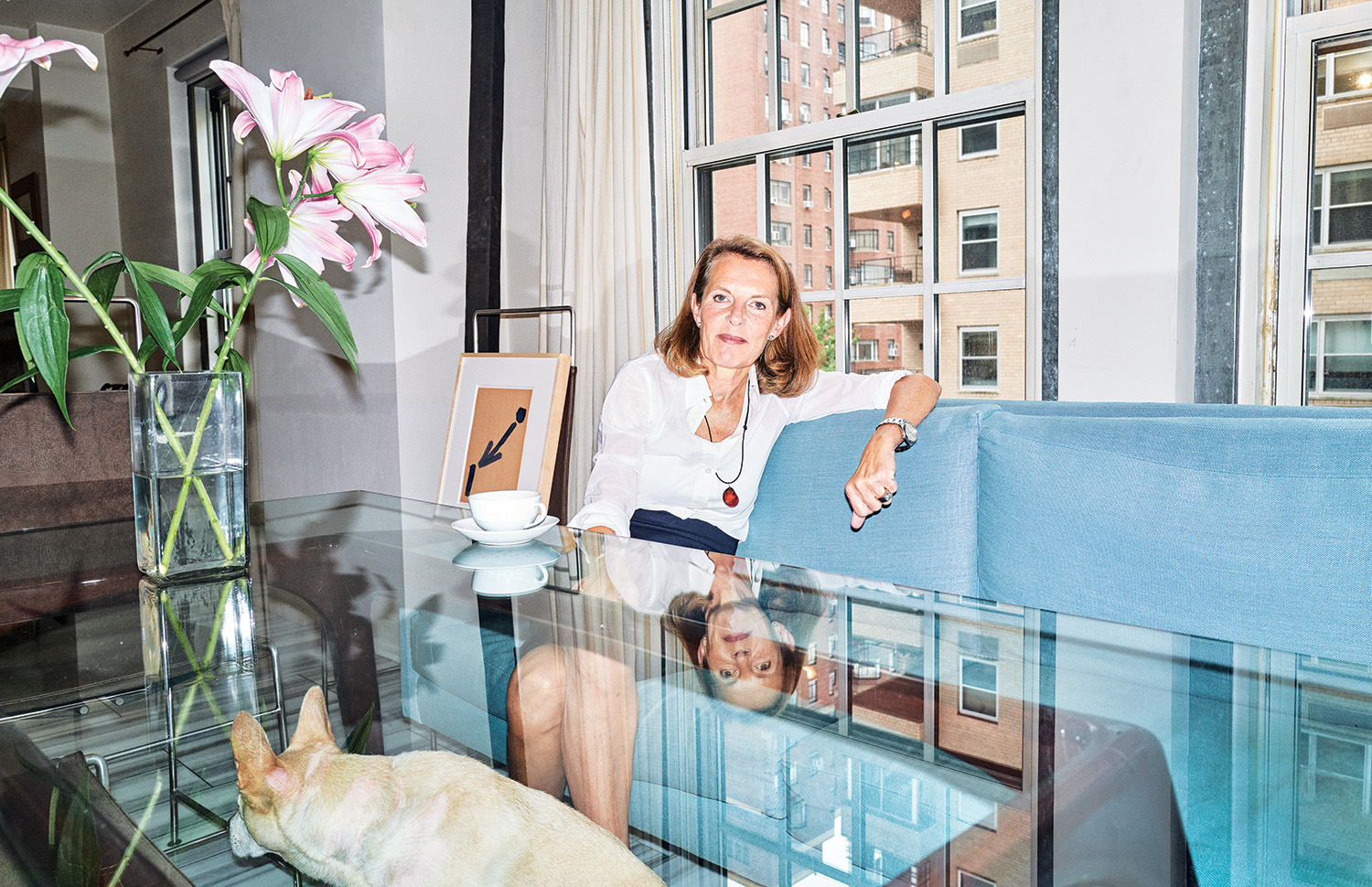
Annabelle Selldorf at home in New York. Photo: JEREMY LIEBMAN
Annabelle Selldorf
A master at bringing the human element to art and architecture, Annabelle Selldorf has been tasked with the first major restoration of the landmark Frick Collection in more than 80 years, propelling the beloved New York institution into the 21st century. But that’s just one of many highly prominent projects the founding principal of Selldorf Architects, a 65-person firm, has ushered through with her signature thoughtful style, which exudes modern, restrained sophistication.
The client list of the German-born talent is a Who’s Who of the art world, with projects for Hauser & Wirth and David Zwirner, including the latter’s new Los Angeles flagship, as well as institutions such as the National Gallery in London; the Smithsonian American Art Museum in Washington, D.C.; and the Museum of Contemporary Art San Diego. “I’m very much driven by understanding what the needs are rather than following a preset path,” says Selldorf. “Architecture ultimately is for people and by people.”
“I, for one, like a quiet environment where the art can speak without being interrupted”
Annabelle Selldorf
Opening in late 2024, the reconceived Frick will allow unprecedented access to the American industrialist’s 1914 home, thanks to Selldorf’s overhaul. “For New Yorkers who have lived with the museum all their lives, I hope that they come to the Frick and find everything that meant something to them—only maybe better,” she says. “And for the tourists who might only have an hour to spare, they should experience the wonder and the beauty of art and the house. We should help them with that.”
Magic formula: “It’s all about balance. I, for one, like a quiet environment where the art can speak without being interrupted.”
Art for all: “I am a firm believer in both encouraging a person’s free will to move about but also giving them the opportunity to let themselves be guided. You don’t want to preclude discovery and curiosity.”
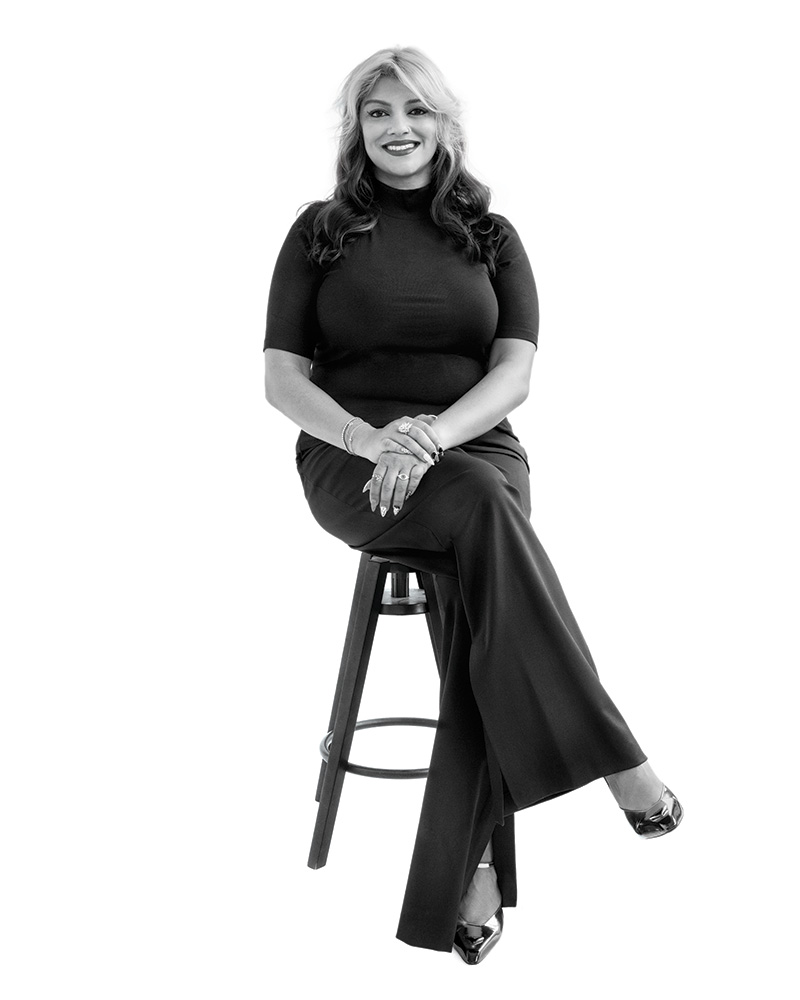
Jasmine Wahi. Photo: JORDAN TIBERIO
Jasmine Wahi
“It is an unapologetically radical ecosystem for creatives,” says curator, educator, and activist Jasmine Wahi, who cofounded Project for Empty Space, a groundbreaking nonprofit arts organization that stages exhibitions as well as provides studios for artists exploring themes of social discourse.
Initially, Wahi set out to establish a series of temporary installations in the real estate left vacant in the wake of 2008’s global economic crisis. “What we have built in the past ten years is so beyond what I ever envisioned back in my early 20s,” says Wahi, who now runs the organization with codirector Rebecca Pauline Jampol. Today, the group oversees approximately 50,000 square feet of space in Newark, New Jersey, and New York’s Chinatown neighborhood, and runs eight major programs, including an artist residency that counts Derrick Adams and Nina Chanel Abney as alumni.
“The art ecosystem shouldn’t be a hierarchical one; it should be lateral with artists and communities at the center”
Jasmine Wahi
New approach: “We need to recognize that the art ecosystem shouldn’t be a hierarchical one with the institution at the top and center,” she says. “It should be lateral with artists and communities at the center. I’m interested in alternatives and new cultural structures.”
Striving for change: “I love what I do, but working in the realm of cultural production and social discourse and social activism is tiring. Sometimes it feels important. Sometimes it feels like shouting into a void. We live in a world that is violent and aflame, and for whatever reason, what I can contribute is making sure people understand what is happening and that we need to do better.”
Upcoming project: Mounted inside a 27-foot-long box truck, “Body Freedom for Every(Body)” is a mobile show celebrating “reproductive justice, queer liberation, and trans joy” with work by some 200 artists, including Marilyn Minter. “There are so many takeaways from this endeavor, but if nothing else, I want people to leave feeling seen and cared for,” Wahi says of the cross-country tour, which kicks off in New York on September 2 with subsequent stops in San Francisco, Miami, and Austin, Texas. “I want viewers to know that we celebrate our body freedoms despite those who would seek to restrict them.”

Wendy Red Star,Fall, (2006). Photo: WENDY RED STAR; COURTESY OF THE ARTIST AND SARGENT’S DAUGHTERS
Wendy Red Star
Representation and visibility are at the center of Wendy Red Star’s expansive, multidisciplinary art practice. The visionary talent, who grew up on the Apsáalooke (Crow) reservation in Montana, uses meticulous research to uncover the hidden histories of her ancestors, findings she channels into dynamic photography, sculpture, video, textile and fiber arts, collage, and site-specific installations that challenge the predominant historical narratives. “I think we need to continue to normalize exhibiting Native artists,” Red Star says, “and not just in one-dimensional shows—but including them with other artists with different themes.”
This summer, “Native America: In Translation,” a traveling exhibition curated by Red Star and featuring the work of nine Indigenous photographers, opens at the Blanton Museum of Art in Austin, Texas. “I was thinking about all the Native artists that I have been interested in over the years. Some are pillars of the contemporary Native arts community and others are not known at all.”
“We need to continue to normalize exhibiting Native artists and not just in one-dimensional shows”
Wendy Red Star
Breakout work: Red Star’s “Four Seasons” (2006), an early four-part photographic series now in the collection of the Metropolitan Museum of Art in New York, pokes fun at the stereotype of Native Americans as being at one with nature. Dressed in traditional Crow regalia, Red Star stages herself with constructed dioramas filled with inflatable animals and artificial materials, challenging ideas of authenticity and identity with a Cindy Sherman–like twist.
Up next: Red Star’s solo show at Roberts Projects in Los Angeles, on view through August 24, includes an ongoing series exploring bishkisché, an Apsáalooke term to describe the 19th-century saddlebags made by Indigenous women. Plus, a solo show shedding light on the last chief of the Crow tribe at the National Portrait Gallery in Washington, D.C., is planned for 2026.
A version of this article first appeared in print in our 2024 Fall Issue under the headline “Women Shaping the Art World.” Subscribe to the magazine.
Cover: Melissa Chiu in front of a monumental commission by Mark Bradford, Pickett’s Charge (2017), at the Hirshhorn Museum and Sculpture Garden in Washington, D.C.
Photo: SHURAN HUANG

